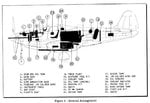Shortround6
Lieutenant General
And on the XP-39 the oil cooler and radiator were in the wing root area ahead of the wheel, but to have good airflow you also need an exhaust duct behind the the radiators/coolers.1st picture shows that 2 air intakes were in each wing, other 2 (feeding glycol cooler) were in wing central section.
Maybe it was never tried because that location is behind the CG. P-39 already changed handling just by having empty ammo magazines in the nose.Also note that at least 3 fuel cells might have been installed outboard of U/C leg attachment point - a simple upgrade that would've increased internal fuel tankage by some 40-50%. The idea never dawned at Bell designers (not trying to be harsh on people).
The P-39 was loved by good pilots but was considered tricky to fly by average or below average pilots. Making it tricker to fly probably is not a good idea. Granted you can use the rear wing tanks first (just like a P-38 ) but take-off, climb-out accidents may increase. Then there is the question of weight. The fuel system in a 120 gal P-39 went about 290lbs. Let us say you can get 40 gallons behind the wing spar (wing is getting thinner) and that your fuel cells only add another 100lbs (they won't, fuel cell/tank weight varies with the surface area of the tank, not it's capacity) empty. Another 240lbs for fuel. P-39s, while small, were heavy. One reason some of the Q's had the fuel capacity cut to 87 gals, increase in performance wasn't worth the loss of range.
It was, sort of, post war. Some of the Thompson Trophy racers put fuel tanks in the wing gun/ammo bays. They managed 100 gal but were using thin wall fuel bladders. They had also replaced the self sealing tanks with thin wall fuel cells/bladders. Two planes were prepared by a group of Bell engineers/employees in their off hours.The reduction of armament into hull-only guns can add another 40-50% of fuel. Never tried.
While a break down of the CG isn't available the list of changes and weight differences is.
They did install a 25 gallon fuel tank in the rear of the fuselage but considering the amount of weight they took out of the plane and the amount of weight they added that doesn't really mean much. Not only did guns, ammo and armor go but so did 109 lbs of radio, 70 lbs of communications equipment, 10lbs worth of window winders, 40lbs worth of instruments, 47lbs worth of engine starter and other items.
Things added include a P-63 25gallon water injection system in the wing, a 75 gallon water tank in the nose, a 4 bladed propeller from a P-63 at 110lbs more than the stock propeller and more.
When they got done the racer/s weighed 47.2lbs more for take-off (clean) than the P-39Q-10 they started with.

